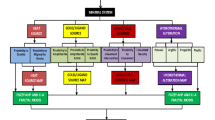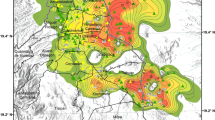Abstract
This paper presents a case study of subsidence hazard mapping in the vicinity of an abandoned coal mine within geographic information system (GIS) environment. A geospatial database was constructed using mine drift maps, topographic maps, land use maps, road maps, building maps, borehole data, and subsidence inventory maps showing occurrences of past subsidence events. Six raster-type factor layers (i.e., an influential area instability (IAI) layer calculated using multiple mine drifts and estimated mined panels, land use, distance from nearest railroad, distance from nearest road, and slope gradient) were generated and extracted from the database to identify relationships between past subsidence occurrences and the factors. Two IAI factors incorporate the complex effects of ground IAI and are calculated using the depths of each underground cavity and its angle of draw. A weight of evidence model was used to establish optimal correlations, expressed as contrast values (CVs) for subsidence inventory data, and inputs of all factors. Six CV layers (one for each factor) were linearly combined to generate a subsidence hazard map representing the relative vulnerability to subsidence in the study area. The area under the cumulative frequency diagram technique was then used to verify predicted subsidence hazards by comparing estimated susceptibility rankings over the entire range of grid cells with actual subsidence occurrences; the proposed GIS analysis model showed an accuracy of 91.09 % in the prediction of subsidence occurrences. Moreover, field surveys showed buildings with severe subsidence-related damage (damage level 4 or 5, according to the National Coal Board) in regions with very high subsidence hazard indices. Finally, a factor negatively correlated with subsidence prediction (slope angle) was determined from the sensitivity analysis.










Similar content being viewed by others
References
Ambrožič T, Turk G (2003) Prediction of subsidence due to underground mining by artificial neural networks. Comput Geosci 29:627–637
Ansal AM, Iyisan R, Güllü H (2001) Microtremor measurements for the microzonation of dinar. Pure Appl Geophys 158:2525–2541. doi:10.1007/PL00001184
Bonham-Carter GF (1994) Geographic Information Systems for Geoscientists. Modeling with GIS. Pergamon Press, Oxford, pp 1–416
Burrough PA, McDonell RA (1998) Principles of geographical information systems. Oxford University Press, Oxford, p 190
Çanakci H, Güllü H (2009) Development of a hazard assessment model for near surface caves in limestone. Eng Geol 105:102–107. doi:10.1016/j.enggeo.2008.12.004
Chang KT (2006) Introduction to geographic information systems. McGraw-Hill Higher Education, Boston, pp 117–122
Choi JK, Kim KD, Lee S, Won JS (2010) Application of a fuzzy operator to susceptibility estimations of coal mine subsidence in Taebaek City, Korea. Environ Earth Sci 59:1009–1022
Coal Industry Promotion Board (1999) Detailed investigation report of the stability test for Simpori. Coal Industry Promotion Board, Seoul, pp 21–208
Cooper AH (2008) The classification, recording, databasing and use of information about building damage caused by subsidence and landslides. Q J Eng Geol Hydroge 41:409–424
Dahal RK, Hasegawa S, Nonomura A, Yamanaka M, Masuda T, Nishino K (2008) GIS-based weights-of-evidence modelling of rainfall-induced landslides in small catchments for landslide susceptibility mapping. Environ Geol 54:311–324
Darling P (2011) SME Mining Engineering Handbook (3rd edn). Society for Mining, Metallurgy, and Exploration (SME), pp 1–1984
Djamaluddin I, Mitani Y, Esaki T (2011) Evaluation of ground movement and damage to structures from Chinese coal mining using a new GIS coupling model. Int J Rock Mech Min Sci 48:380–393
Güllü H (2012) Prediction of peak ground acceleration by genetic expression programming and regression: a comparison using likelihood-based measure. Eng Geol 141–142:92–113. doi:10.1016/j.enggeo.2012.05.010
Güllü H (2013) On the prediction of shear wave velocity at local site of strong ground motion stations: an application using artificial intelligence. Bull Earthq Eng 11:969–997. doi:10.1007/s10518-013-9425-8
Güllü H, Erçelebi E (2007) A neural network approach for attenuation relationships: an application using strong ground motion data from Turkey. Eng Geol 93:65–81. doi:10.1016/j.enggeo.2007.05.004
Güllü H, İyisan R (2015) A seismic hazard study through the comparison of ground motion prediction equations using the weighting factor of logic tree. J Earthq Eng. doi:10.1080/13632469.2015.1104752
Güllü H, Pala M (2014) On the resonance effect by dynamic soil–structure interaction: a revelation study. Nat Hazards 72:827–847. doi:10.1007/s11069-014-1039-1
Gullu H, Ansal AM, Ozbay A (2008) Seismic hazard studies for Gaziantep city in South Anatolia of Turkey. Nat Hazards 44:19–50. doi:10.1007/s11069-007-9140-3
Hartman HL, Mutmansky JM (2002) Introductory mining engineering (2nd edn). Wiley, New York, pp 1–584
Jung YB, Song WK, Kang SS (2008) Development of subsidence hazard estimation method based on the depth of gangway. Tunnel Undergr Space 18:272–279
Kim KD, Lee S, Oh HJ, Choi JK, Won JS (2006) Assessment of ground subsidence hazard near an abandoned underground coal mine using GIS. Environ Geol 50:1183–1191
Kim KD, Lee S, Oh HJ (2009) Prediction of ground subsidence in Samcheok City, Korea using artificial neural networks and GIS. Environ Geol 58:61–70
Kratzsch H (1983) Mining subsidence engineering. Springer, Berlin, pp 1–543
Lee S, Choi J (2004) Landslide susceptibility mapping using GIS and the weight-of-evidence model. Int J Geogr Inf Sci 18:789–814
Lee S, Park I (2013) Application of decision tree model for the ground subsidence hazard mapping near abandoned underground coal mines. J Environ Manage 127:166–176
Malinowska A, Hejmanowski R (2010) Building damage risk assessment on mining terrains in Poland with GIS application. Int J Rock Mech Min Sci 47:238–245
Mancini F, Stecchi F, Gabbianelli G (2009) GIS-based assessment of risk due to salt mining activities at Tuzla (Bosnia and Herzegovina). Eng Geol 109:170–182
Mine Reclamation Corporation (2008) Technical report of the development of ground stability evaluation method and software for subsidence occurrence in mine area in Korea. Mine Reclamation Corporation, Seoul, pp 123–143
Mine Reclamation Corporation (2010) Database guideline of mine geographic information system. Mine Reclamation Corporation, Seoul, pp 20–39
Mine Reclamation Corporation (2012) Yearbook of MIRECO statistics 2011. Mine Reclamation Corporation, Seoul, pp 1–331
National Coal Board (1975) Subsidence Engineers’ Handbook. National Coal Board Mining Department, UK, pp 1–111
Oh HJ, Lee S (2010) Assessment of ground subsidence using GIS and the weights-of-evidence model. Eng Geol 115:36–48
Oh HJ, Lee S (2011) Integration of ground subsidence hazard maps of abandoned coal mines in Samcheok, Korea. Int J Coal Geol 86:58–72
Oh HJ, Ahn SC, Choi JK, Lee S (2011) Sensitivity analysis for the GIS-based mapping of the ground subsidence hazard near abandoned underground coal mines. Environ Earth Sci 64:347–358
Park I, Choi J, Lee MJ, Lee S (2012) Application of an adaptive neuro-fuzzy inference system to ground subsidence hazard mapping. Comput Geosci 48:228–238
Song J, Choi Y (2016) Analysis of wind power potentials at abandoned mine promotion districts in Korea. Geosyst Eng 19:77–82
Song J, Choi Y, Yoon SH (2015) Analysis of photovoltaic potential at abandoned mine promotion districts in Korea. Geosyst Eng 18:168–172
Suh J, Choi Y, Park HD, Yoon SH, Go WR (2013) Subsidence hazard assessment at the Samcheok coalfield, South Korea: a case study using GIS. Environ Eng Geosci 19:69–83
Yilmaz I (2009) Landslide susceptibility mapping using frequency ratio, logistic regression, artificial neural networks and their comparison: a case study from Kat landslides (Tokat-Turkey). Comput Geosci 35:1125–1138
Acknowledgments
This work was supported by a KETEP grant funded by the Korea Government’s Ministry of Trade, Industry, and Energy (Project No. 2013T100100021) and the Basic Science Research Program through the National Research Foundation of Korea (NRF) funded by the Ministry of Education (2015R1D1A1A01061290).
Author information
Authors and Affiliations
Corresponding author
Rights and permissions
About this article
Cite this article
Suh, J., Choi, Y. & Park, HD. GIS-based evaluation of mining-induced subsidence susceptibility considering 3D multiple mine drifts and estimated mined panels. Environ Earth Sci 75, 890 (2016). https://doi.org/10.1007/s12665-016-5695-1
Received:
Accepted:
Published:
DOI: https://doi.org/10.1007/s12665-016-5695-1




